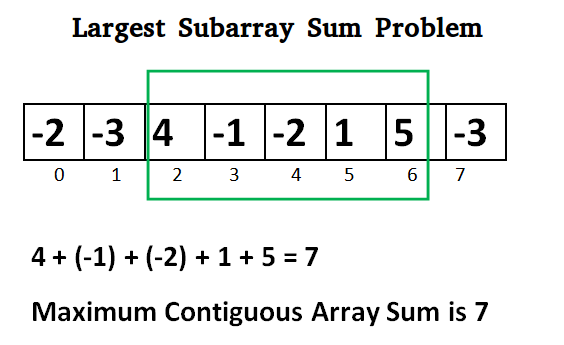C / C++ Program for Largest Sum Contiguous Subarray
Last Updated :
12 Oct, 2023
Write a C/C++ program for a given array arr[] of size N. The task is to find the sum of the contiguous subarray within a arr[] with the largest sum.

C / C++ Program for Largest Sum Contiguous Subarray using Kadane’s Algorithm:
The idea of Kadane’s algorithm is to maintain a variable max_ending_here that stores the maximum sum contiguous subarray ending at current index and a variable max_so_far stores the maximum sum of contiguous subarray found so far, Everytime there is a positive-sum value in max_ending_here compare it with max_so_far and update max_so_far if it is greater than max_so_far.
So the main Intuition behind Kadane’s algorithm is
- The subarray with negative sum is discarded (by assigning max_ending_here = 0 in code).
- we carry subarray till it gives positive sum.
Pseudocode:
Initialize:
max_so_far = INT_MIN
max_ending_here = 0
Loop for each element of the array
(a) max_ending_here = max_ending_here + a[i]
(b) if(max_so_far < max_ending_here)
max_so_far = max_ending_here
(c) if(max_ending_here < 0)
max_ending_here = 0
return max_so_far
Illustration:
Lets take the example:
{-2, -3, 4, -1, -2, 1, 5, -3}
max_so_far = max_ending_here = 0
for i=0, a[0] = -2
max_ending_here = max_ending_here + (-2)
Set max_ending_here = 0 because max_ending_here < 0
for i=1, a[1] = -3
max_ending_here = max_ending_here + (-3)
Set max_ending_here = 0 because max_ending_here < 0
for i=2, a[2] = 4
max_ending_here = max_ending_here + (4)
max_ending_here = 4
max_so_far is updated to 4 because max_ending_here greater
than max_so_far which was 0 till now
for i=3, a[3] = -1
max_ending_here = max_ending_here + (-1)
max_ending_here = 3
for i=4, a[4] = -2
max_ending_here = max_ending_here + (-2)
max_ending_here = 1
for i=5, a[5] = 1
max_ending_here = max_ending_here + (1)
max_ending_here = 2
for i=6, a[6] = 5
max_ending_here = max_ending_here + (5)
max_ending_here = 7
max_so_far is updated to 7 because max_ending_here is
greater than max_so_far
for i=7, a[7] = -3
max_ending_here = max_ending_here + (-3)
max_ending_here = 4
Follow the below steps to Implement the idea:
- Initialize the variables max_so_far = INT_MIN and max_ending_here = 0
- Run a for loop from 0 to N-1 and for each index i:
- Add the arr[i] to max_ending_here.
- If max_so_far is less than max_ending_here then update max_so_far to max_ending_here.
- If max_ending_here < 0 then update max_ending_here = 0
- Return max_so_far
Below is the Implementation of the above approach.
C++
#include <climits>
#include <iostream>
using namespace std;
int maxSubArraySum(int a[], int size)
{
int max_so_far = INT_MIN, max_ending_here = 0;
for (int i = 0; i < size; i++) {
max_ending_here = max_ending_here + a[i];
if (max_so_far < max_ending_here)
max_so_far = max_ending_here;
if (max_ending_here < 0)
max_ending_here = 0;
}
return max_so_far;
}
int main()
{
int a[] = { -2, -3, 4, -1, -2, 1, 5, -3 };
int n = sizeof(a) / sizeof(a[0]);
int max_sum = maxSubArraySum(a, n);
cout << "Maximum contiguous sum is " << max_sum;
return 0;
}
|
Output
Maximum contiguous sum is 7
Output:
Maximum contiguous sum is 7
Time Complexity: O(n)
Auxiliary Space: O(1)
Print the Largest Sum Contiguous Subarray:
To print the subarray with the maximum sum the idea is to maintain start index of maximum_sum_ending_here at current index so that whenever maximum_sum_so_far is updated with maximum_sum_ending_here then start index and end index of subarray can be updated with start and current index.
Follow the below steps to implement the idea:
- Initialize the variables s, start, and end with 0 and max_so_far = INT_MIN and max_ending_here = 0
- Run a for loop from 0 to N-1 and for each index i:
- Add the arr[i] to max_ending_here.
- If max_so_far is less than max_ending_here then update max_so_far to max_ending_here and update start to s and end to i .
- If max_ending_here < 0 then update max_ending_here = 0 and s with i+1.
- Print values from index start to end.
Below is the Implementation of above approach:
C++
#include <climits>
#include <iostream>
using namespace std;
void maxSubArraySum(int a[], int size)
{
int max_so_far = INT_MIN, max_ending_here = 0,
start = 0, end = 0, s = 0;
for (int i = 0; i < size; i++) {
max_ending_here += a[i];
if (max_so_far < max_ending_here) {
max_so_far = max_ending_here;
start = s;
end = i;
}
if (max_ending_here < 0) {
max_ending_here = 0;
s = i + 1;
}
}
cout << "Maximum contiguous sum is " << max_so_far
<< endl;
cout << "Starting index " << start << endl
<< "Ending index " << end << endl;
}
int main()
{
int a[] = { -2, -3, 4, -1, -2, 1, 5, -3 };
int n = sizeof(a) / sizeof(a[0]);
maxSubArraySum(a, n);
return 0;
}
|
Output
Maximum contiguous sum is 7
Starting index 2
Ending index 6
C / C++ Program for Largest Sum Contiguous Subarray using Dynamic Programming:
C++
#include <bits/stdc++.h>
using namespace std;
void maxSubArraySum(int a[], int size)
{
vector<int> dp(size, 0);
dp[0] = a[0];
int ans = dp[0];
for (int i = 1; i < size; i++) {
dp[i] = max(a[i], a[i] + dp[i - 1]);
ans = max(ans, dp[i]);
}
cout << ans;
}
int main()
{
int a[] = { -2, -3, 4, -1, -2, 1, 5, -3 };
int n = sizeof(a) / sizeof(a[0]);
maxSubArraySum(a, n);
return 0;
}
|
Output:
Maximum contiguous sum is 7
Time Complexity: O(n)
Auxiliary Space: O(1)
Practice Problem:
Given an array of integers (possibly some elements negative), write a C program to find out the *maximum product* possible by multiplying ‘n’ consecutive integers in the array where n ? ARRAY_SIZE. Also, print the starting point of the maximum product subarray.
Please refer complete article on Program for Largest Sum Contiguous Subarray for more details!
Like Article
Suggest improvement
Share your thoughts in the comments
Please Login to comment...